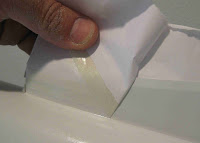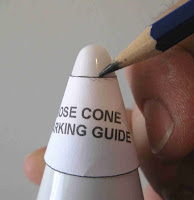The panel covers are glued on over the decal locations.
I've drawn some faint pencil lines inside the border lines of the panel decal.
In this pencil line the decal, paint and primer will have to be scraped off for better glue adhesion.
 To prevent chipping of the paint, score a light cut down the pencil lines.
To prevent chipping of the paint, score a light cut down the pencil lines.With the tip and sides of an X-Acto knife, scrape away the decal, white paint, grey primer down to the body tube.
Notice the edges are straight and clean, this is because the edge was scored before scraping off the paint.
Here's the panels glued in place. I used white glue, it dries clear and any excess is invisible.
A fillet was added to all sides of the panel edges. This helps hide any gaps and gives the illusion that the fit is better than it might be.







































